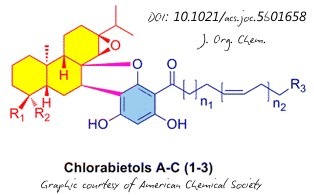In my latest research highlight for ChemistryViews I discuss Chloranthus oldhamii Solms-Laub, a seemingly nondescript plant that nestles in the damp and shadowy places of remote Chinese mountains. It is rarely seen and barely touched by human hands. Now, Jin-Feng Hu of Fudan University in Shanghai and colleagues have extracted several entirely novel natural products from this plant, which they call chlorabietols. These compounds have a certain activity against the protein tyrosine phosphatase, which is linked to Type II diabetes and cancer.

Professor of Pharmacy Ciddi Veeresham of Kakatiya University, in Warangal India, told me that the works is “excellent, interesting and thought provoking. “This paper could ignite and motivate researchers working in the areas of taxonomy, medicinal chemistry, pharmacology and pharmacognosy. It could lead to novel chemical structural molecules with an interesting pharmacophore that in turn become novel therapeutic molecules for the treatment of various diseases such as diabetes and cancer.” You can read details of this work on the CV site, but Hu told me about his earlier work and the ongoing efforts to preserve endangered plant species and to isolate and test their physiologically active natural products.
Prior to this work, Hu and colleagues investigated another rare Chloranthus species endemic in China, C. sessilifolius K. F. Wu, he told me. “This plant, also barely touched by human hands, is a perennial herb generally growing in damp areas in forests at an altitude of about 1000−1200 m in the Fengqi Mountain areas in the Sichuan Province.” The team isolated fourteen new ent-abietane-type diterpenoids, sessilifols A−N and three related new norditerpenoids were isolated from the whole plant. They determined the absolute configurations by single-crystal Xray diffraction analysis, the modified Mosher’s method, and/or the observed Cotton effects in their electronic circular dichroism spectra.
Hu told me that sessilifols A (1) and B (2) possess an uncommon five-membered carbon ring rearranged by oxidative cleavage of the C-13/C-14 bond in abieta-7,13-diene followed by the formation of a new C−C bond between C-12 and C-14. Sessilifol C (3) is a rare 7,8-seco-9-spiro-fused ent-abietane, whereas sessilifol O (15) represents the first example of a naturally occurring 14-norabietane-type diterpenoid. Among them, sessilifols F (6) and I (9) were found to have remarkable antineuro-inflammatory activities by inhibiting the nitric oxide production in lipopolysaccharide-stimulated murine BV-2 microglial cells, with IC50 values of 8.3 and 7.4 micromolar, respectively. “This study may contribute to further exploration of the therapeutic potential of the ent-abietenes in neurodegenerative and other aging-associated diseases (e.g., Alzheimer’s Disease, AD),” Hu told me. [J. Nat. Prod. 2015, 78, 1635−1646 (http://dx.doi.org/10.1021/acs.jnatprod.5b00195)].
“Natural products (NPs) continue to provide a highly productive resource for the discovery and development of new, innovative disease treatments,” he explains. “There is a significant need for new drugs to treat diabetes and AD.” Moreover, based on recent data (PNAS 2013, 110: 16832—16837; 2011, 108: 12943-12848) suggesting that rare and endangered plant species and their associated bacteria/fungal (endophytes) are actively involved drugs in the past, current, and future, the rare and endangered plants have proven to be better sources for drug discovery when compared to other natural sources.
Hu adds that, worldwide, at least 13% of known plant species are endangered or threatened. “The situation is much more serious in China which is one of the richest countries regarding plant biodiversity, ranking third in the world (after Brazil and Colombia) in the number of species,” he says. “There is an urgent need to investigate the rare and endangered plant species endemic to China,” Hu told me. “We would like to launch a new era to systematically identify NPs from those plants in the China Plant Red Data Book,” he adds. Hu’s own group and collaborators are conducting individual projects related to this overall research goal.